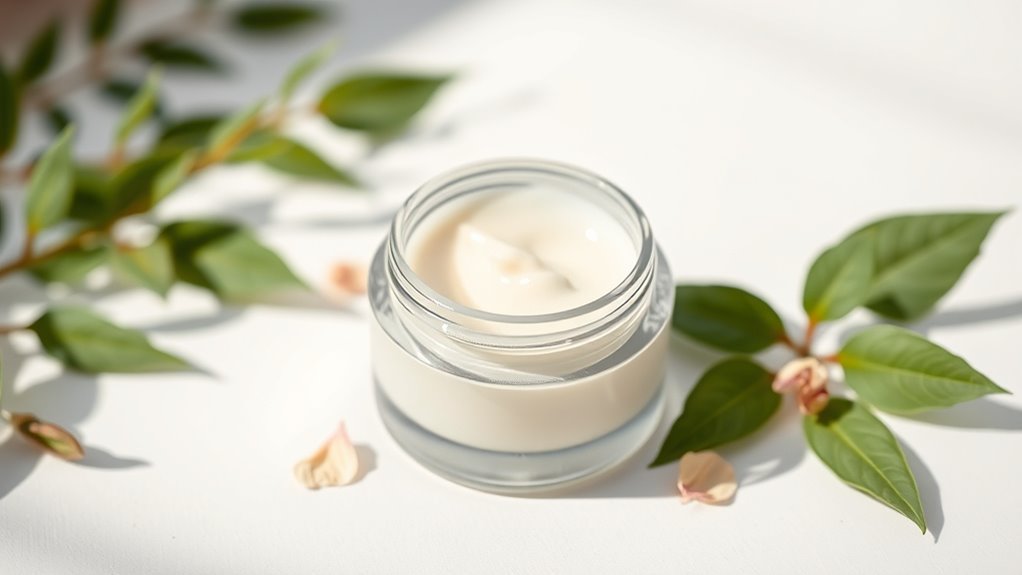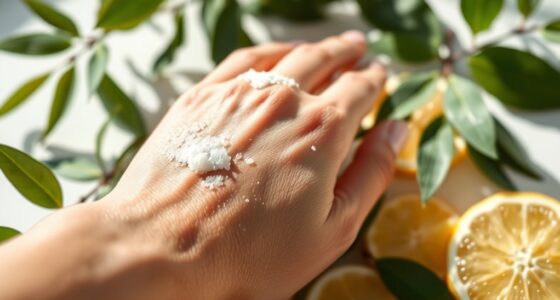“Clean beauty” isn’t legally defined, so labels can be misleading. It often suggests products with natural ingredients and fewer harmful chemicals, but these claims aren’t regulated. Brands may use vague terms like “non-toxic” without transparency about ingredients. To truly understand what’s in a product, you need to check the ingredient list and sourcing details. Want to uncover how to spot genuine clean beauty and avoid misleading labels? Keep exploring to learn more.
Key Takeaways
- “Clean beauty” lacks a formal legal or regulatory definition, making it a marketing term rather than an official category.
- Labels often emphasize natural ingredients but do not guarantee safety or absence of harmful substances.
- Transparency in ingredient lists is essential; brands that disclose all components help consumers make informed choices.
- Vague claims like “non-toxic” are common marketing tactics; consumers should scrutinize ingredient details instead.
- Certification seals can assist but are not always strict; thorough label reading and research are key to understanding product safety.

What exactly does “clean beauty” mean, and how can you tell if a product truly fits that label? The term might seem straightforward, but in reality, it’s more of a marketing term than a regulated category. Generally, clean beauty implies that a product is made with natural ingredients and free from potentially harmful substances. However, since there’s no official legal definition, the label can be quite subjective. To truly understand if a product fits the clean beauty bill, you need to look beyond the buzzwords and focus on ingredient transparency. This means clear, honest labeling that discloses every ingredient used. When a brand practices ingredient transparency, you’re better equipped to determine whether the product contains synthetic chemicals, parabens, phthalates, or other substances you might want to avoid.
Focusing on natural ingredients is a good starting point, but it’s not enough on its own. Just because an ingredient sounds natural doesn’t automatically make it safe or effective. Some natural ingredients can cause allergic reactions or irritation, so it’s essential to know how they’re processed and sourced. That’s where ingredient transparency becomes vital. Brands that prioritize transparency provide detailed ingredient lists and, in many cases, information about the sourcing and manufacturing process. This helps you assess whether a product aligns with your values and safety standards.
You should also be wary of vague claims like “non-toxic” or “free from harmful chemicals” without any specifics. These are often marketing tactics designed to appeal to consumers looking for safer options. Instead, look for products that openly share their ingredient lists and avoid hiding behind generic terms. Transparency also extends to how ingredients are sourced—whether they’re ethically farmed or sustainably harvested—so you can make more informed choices.
Avoid vague claims; choose brands that openly share ingredient lists and sourcing practices for truly transparent beauty.
Remember that “clean” isn’t a regulated term, so it’s up to you to do your homework. Read labels carefully, research unfamiliar ingredients, and look for brands committed to honesty. Certification seals can help, but they’re not always comprehensive or strict. Additionally, be aware that air pollution and environmental contaminants can impact the safety and efficacy of natural ingredients in products. Ultimately, a truly clean beauty product should prioritize natural ingredients while maintaining ingredient transparency, giving you the confidence that what you’re putting on your skin aligns with your health and ethical standards. Staying informed and vigilant is the best way to decode the true meaning behind clean beauty labels.
Frequently Asked Questions
Are “Clean Beauty” Products Always Cruelty-Free?
You might wonder if “clean beauty” products are always cruelty-free. While many are, it’s not guaranteed, as some can still contain chemical preservatives or animal-derived ingredients. Always check labels for cruelty-free certifications, but remember that “clean beauty” mainly focuses on avoiding harmful chemicals and embracing botanical extracts. So, don’t assume cruelty-free status; confirm with trusted labels to ensure your values align with your choices.
How Do “Clean” Labels Differ Worldwide?
Did you know that “clean” labels vary markedly worldwide? Regulatory variations mean some countries enforce strict ingredient bans, while others have lax rules. Cultural perceptions also influence what’s considered “clean,” with natural ingredients valued more in certain regions. As a result, a product labeled “clean” in one country might not meet the same standards elsewhere. You should always check local regulations and understand cultural differences to make informed choices.
Can “Clean” Products Still Cause Allergies?
You might wonder if “clean” products can still cause allergies. Even with claims of natural ingredients or hypoallergenic formulations, reactions are possible because natural ingredients aren’t always non-irritating. Always check ingredient lists carefully, as “clean” labels don’t guarantee allergy-free results. While these products aim to be gentler, individual sensitivities vary, so it’s wise to patch test and consult with a dermatologist if you have concerns.
Are “Clean” Ingredients Always Safe for Sensitive Skin?
You might think “clean” ingredients are always safe for sensitive skin, but that’s not guaranteed. Even natural preservatives can cause reactions, and some brands use synthetic chemicals labeled as “clean.” Always check ingredient lists carefully, as “clean” doesn’t mean allergy-proof. If you have sensitive skin, patch-test new products and choose formulas with gentle, known ingredients to minimize irritation.
Do “Clean” Labels Guarantee Long-Term Safety?
You might wonder if “clean” labels guarantee long-term safety, but they don’t. These labels often lack strict regulatory standards, so ingredient transparency varies between brands. While some companies prioritize safety, others might not fully disclose all ingredients or meet rigorous safety tests. It’s essential to research brands carefully, look for transparency, and stay informed about ingredients, rather than relying solely on “clean” labels for long-term safety.
Conclusion
Now that you understand what “clean beauty” really means, you can navigate labels with confidence. Think of it like a map guiding you through a maze—clear, straightforward, and trustworthy. Remember, the label isn’t always a guarantee, but being informed helps you make better choices for your skin and the environment. So, next time you shop, you’ll see the label like a friendly signpost pointing you toward safer, more transparent beauty options.









